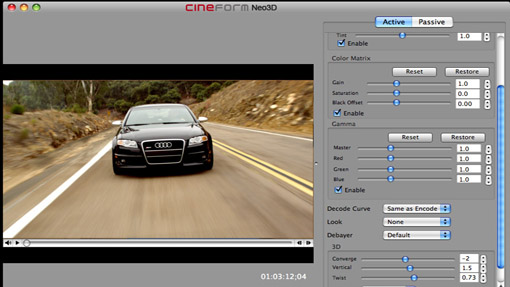CineForm CTO David Newman explains how the Neo3D plug-in for Final Cut Pro was built to bring top-of-class 3D tools to a broader editing universe.

What first led to Neo3D’s development?
Traditionally, when you do a 3D edit, you have to do a 2D edit first. We knew Avid was dabbling with solutions for this, but the DNxHD codec wasn’t broad enough to handle everything. For example, you had an under/over view, so you only got half of the visual information for each scene. We asked ourselves, “How can we make a tool that uses all the same 3D tools available now to studio filmmakers finishing on higher-end systems for folks working on Final Cut Pro?” We’re not interested in building a new commodity editor, and we recognized that the majority of editors working at the next tier down in our space were editing in Final Cut Pro. What we were after was a way to be able to edit and view your 3D as you worked. We found that, with the codec, we could put both the left and right eye view into one stream, and then the codec decides how to handle it.
If you want to set up your own DI suite, you can send out your footage to two projectors, for example. The codec handles any resolution. But the goal with this plug-in is to help the up-and-coming filmmakers with tighter budgets get 3D done in a much smaller environment.
We’re seeing a lot of interest from the exhibition market and a lot of commercial work. In the UK, two broadcasters have plans to launch dedicated 3D channels, and if you play all the current 3D content, back-to-back for 24 hours, there’s only about a week’s worth of content. There is a huge demand for more 3D content, and other companies are looking at 2D-to-3D conversion as another way to fill this void. When you look at Neo3D, it’s definitely tailored to live action, as opposed to CG. There will be a flood of live-action 3D material coming, and we wanted to be there to make it happen. I’m off shortly to the Jackson Hole Wildlife Film Festival, for example. Wildlife footage is really suitable for 3D because you can shorten distance setups. Wildlife cinematography will be huge, and one can easily imagine a Discovery Channel 3D or Animal Planet 3D coming in the future.
What are some of Neo3D’s unique features?
One of things that’s key is the tool allows you to fix camera alignment, and in the new version that comes out this week, you’ll have individual left eye and right eye zoom correction. There is also some more control within the FCP timeline itself. In the next upgrade, we’ll add keyframing. Because it’s software-based, we can add new features fairly rapidly. The next release of the codec is going to have all you’ll need to finish your 3D film, if you wanted to. It handles 99.9% of what goes wrong on a 3D picture. But those using Final Cut as an offline can still go to a Pablo or an Iridas, but for a low-budget or broadcast show, you could finish in 3D on Final Cut.
For more information about Neo3D, visit www.cineform.com.
Topics: Uncategorized
Did you enjoy this article? Sign up to receive the StudioDaily Fix eletter containing the latest stories, including news, videos, interviews, reviews and more.